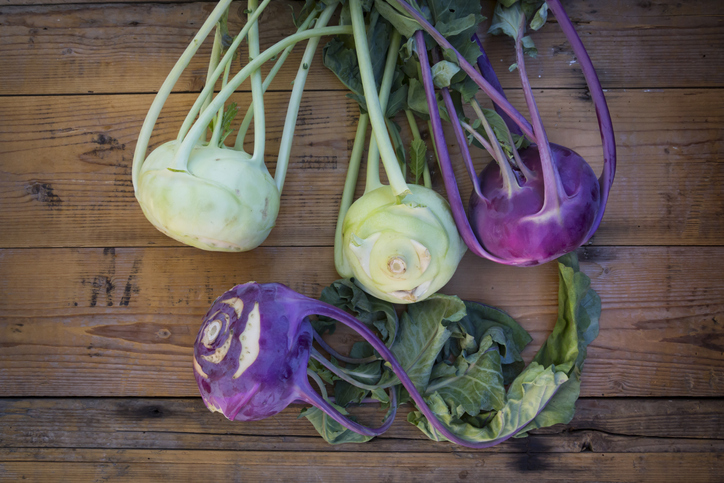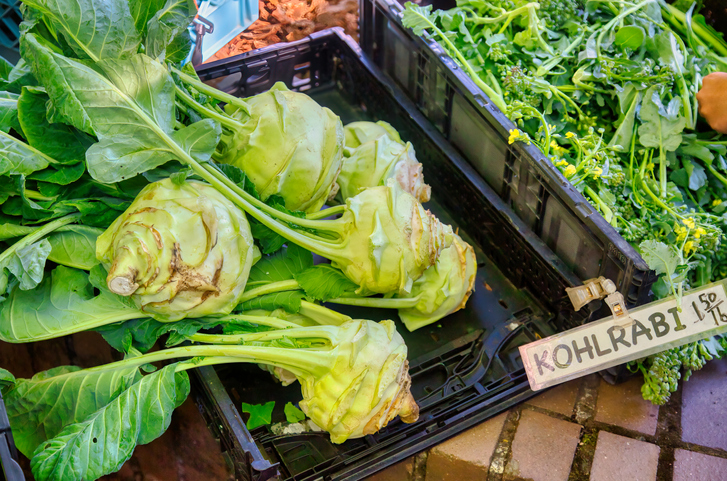Kohlrabi is King

By: Sydney Kronfle, pH Labs Researcher & Contributor
On a recent trip to my local farmers market, I came across an interesting looking piece of produce. It was a vibrant purple color, about the size of an orange and had lush leaves sprouting from the top. If a beet had a baby with a cabbage, to me this is what this plant would have been.
“Kohlrabi,” the vendor said to me.
“I beg your pardon,” I replied.
“Kowl-raa-bee,” he sounded out. “Kohlrabi. Kind of tastes like broccoli stems.”
I couldn’t help turning my nose up. I honestly don’t love the taste of broccoli, so broccoli stems (the part that is usually thrown away) was not exactly tempting me to put some kohlrabi in my basket.
He laughed at my expression and admitted that probably wasn’t the best sell. He then proceeded to tell me more about the taste. Kohlrabi actually has the peppery taste of broccoli stems along with the sweetness of a turnip and tang of radish.

You can eat kohlrabi raw. It’s perfect for grating into simple salads for some added texture and nutrients. Making a slaw with kohlrabi is also a nice way to prepare this vegetable and pair it with other veggies (check out this carrot and kohlrabi slaw).
There are also a number of ways to cook kohlrabi. It is actually popular in Indian cuisine and can be used to make curry. Both the bulb and leaves of the plant are edible.
"If you want to emphasize its sweetness, try adding a pinch of sugar when you're cooking kohlrabi,” according to the Food Network.
So what exactly is kohlrabi?
Kohlrabi is a cruciferous vegetable (along with veggies such as broccoli, cauliflower, kale, bok choy and brussels sprout). Cruciferous veggies are known for their cancer-fighting properties.
“Cruciferous vegetables are a rich source of glucosinolates and their hydrolysis products, including indoles and isothiocyanates, and high intake of cruciferous vegetables has been associated with lower risk of lung and colorectal cancer in some epidemiological studies,” reports the NIH.
Kohlrabi is native to northern Europe. The word “kohlrabi” is a German word. “Kohl” means “cabbage,” and “rabi” means “turnip.” So it makes sense that kohlrabi is also called “German turnip” and “cabbage turnip''.
Kohlrabi comes in different colors, including white, green and purple (keep in mind the inside will always be a white-yellowish color). I was happy to come across the purple, because it will make such a beautiful slaw when combined with the color of the carrot.
Let's explore some of the nutrients found in kohlrabi.
Vitamin C
Believe it or not, but one cup of kohlrabi has more vitamin C than a medium-sized orange! Vitamin C is an antioxidant that is so critical to the health of our cells and our survival. This vitamin can help you build and maintain collagen. You lose collagen as you age, which weakens the elasticity of the skin. With its antioxidant properties, vitamin C helps protect the skin against free radicals we are all exposed to in the environment. This vitamin also promotes strong, healthy hair and nails. And as you probably know, vitamin C is great at boosting your immune system and fighting off colds.
Potassium
Potassium is an essential mineral that works with sodium to balance the fluid and electrolytes in the body. Potassium also helps keep blood pressure under control and may help reduce kidney stones and bone loss as you age. It may even reduce your risk of stroke.
Fiber
Kohlrabi is a great source of both insoluble and soluble fiber. Insoluble fiber does not dissolve in water and is the type of fiber that makes you regular and prevents constipation. It helps food move through your digestive system like a broom. Soluble fiber is a type of fiber which dissolves in water and swells like a sponge in the stomach, giving food a jellylike bulk. It combines with fat in the intestines and pulls it out of the body before it can enter the bloodstream. It is soluble fiber that may help lower blood cholesterol, slow the absorption of carbohydrates from foods and help stabilize blood sugar levels.
Vitamin B6
Vitamin B6 is involved in more than 100 enzyme reactions in the body which are mostly concerned with protein metabolism, according to the National Institutes of Health (NIH).
“Vitamin B6 also plays a role in cognitive development through the biosynthesis of neurotransmitters and in maintaining normal levels of homocysteine, an amino acid in the blood. Vitamin B6 is involved in gluconeogenesis and glycogenolysis, immune function (for example, it promotes lymphocyte and interleukin-2 production), and hemoglobin formation.”
Kohlrabi is also low-calorie, water-rich and, as mentioned, full of fiber, so it may aid in weight loss and gut health by preventing constipation, dehydration and hunger pangs.
Prepare it properly.
You must peel Kohlrabi. The outer layer is very tough and indigestible. Watch this video to see steps on how to prepare this veggie. For more kohlrabi recipes, click here.
As always, consult your doctor or a competent healthcare professional when it comes to introducing new foods to your diet, especially if you have any existing health issues or are taking any medications.
Enjoy your healthy life!
The pH professional health care team includes recognized experts from a variety of health care and related disciplines, including physicians, attorneys, nutritionists, nurses, and certified fitness instructors. This team also includes the members of the pH Medical Advisory Board, which constantly monitors all pH programs, products, and services. To learn more about the pH Medical Advisory Board, click here.







